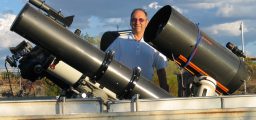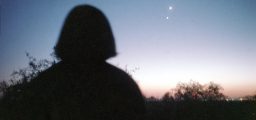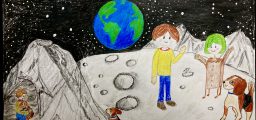Skyward for October 2021 By David H. Levy

Fond memories of Carolyn Shoemaker
One clear evening during the summer of 2019, I was using Pegasus, one of my childhood friend Carl’s telescopes, at our annual Adirondack Astronomy Retreat. When my cellphone began to ring, I picked it up with some surprise. At the other end of the line was Carolyn Shoemaker. I was thrilled to hear from her, as it had been some time since our last contact. Carolyn was doing well, except for a mild loss of hearing. She had called to say that since her daughter and son-in-law had moved to New Mexico, she would be living at the Peaks, a comfortable assisted living facility in Flagstaff. My colleague Brent Archinal gave me her cell phone number. I was able to speak with her again a few months later. I wanted to find a way to increase the frequency of our conversations. “You speak with your brother Richard every Monday,” Wendee commented, and suggested, “Why not call Carolyn every Monday as well?
For the next 18 months that’s what I did. Carolyn would pick up the phone and announce, “It is David. It must be Monday!” Wendee would often join the discussion as well. But when I called on Monday, August 9, no one answered. After repeated tries, her daughter Linda called to say that Carolyn had had a minor fall and was in the hospital. On Thursday evening, August 12, she went into respiratory arrest. Carolyn died the next morning at 10:40 A.M. Arizona time.
With her husband Gene and the five-year comet and asteroid program we shared, Carolyn was responsible for a very rich period in my life. In fact, virtually every article one reads about the Shoemakers will agree that the discovery and impacts of Comet Shoemaker-Levy 9 were the most significant part of our professional lives.
Carolyn began her observing project a few years after her husband Gene was disqualified as a potential astronaut because of Addison’s disease. He decided to go at the problem of impacts, not from studying craters as he walked about on the Moon, but from the opposite direction of the comets and asteroids that collide with the Moon, and with the Earth. Carolyn quickly learned to become proficient at using the stereomicroscope. She would place two films into the microscope; they were identical except that the second plate would be about 45 minutes later than the first. The films were almost always identical, except that when an asteroid was moving slowly, it would appear to float above the starry background. Carolyn discovered 377 asteroids this way, each one charted until its orbit round the Sun could be determined accurately. When one included the asteroids for which orbits have not yet been determined, that number rose significantly, according to Carolyn, to about 800.
In 1983 Carolyn discovered the first of her 32 comets. When their colleague Henry Holt joined the following year, the number of new comets rose rapidly. It was only a year or two after that when she surpassed the number of comets another famous astronomer, Caroline Herschel, discovered, and Sky & Telescope published a news note about “Carolyn passing Caroline.” I joined the team in 1989. In a sense, passing Herschel’s record might have been Carolyn’s golden moment, but it wasn’t. That came later on a cloudy and dull day on March 25, 1993. Two nights earlier I had taken two exposures that she was scanning. Suddenly looking up, she announced “I don’t know what I have, but it looks like a squashed comet.” That was the discovery moment of Comet Shoemaker-Levy 9. Sixteen months later, when the 21 pieces of this fragmented collided with Jupiter, we got to meet President Clinton and chat amiably with Vice President Gore and share the world’s excitement over the first collision of a comet and a planet ever witnessed by humans. It was a satisfying peak to all our careers.
After Gene died in a car accident in Australia, Carolyn continued observing with Wendee and me for several years. One evening she confided that sometimes she wished she had died with Gene. But she did not and the world was able to enjoy her company.




Comments are closed.